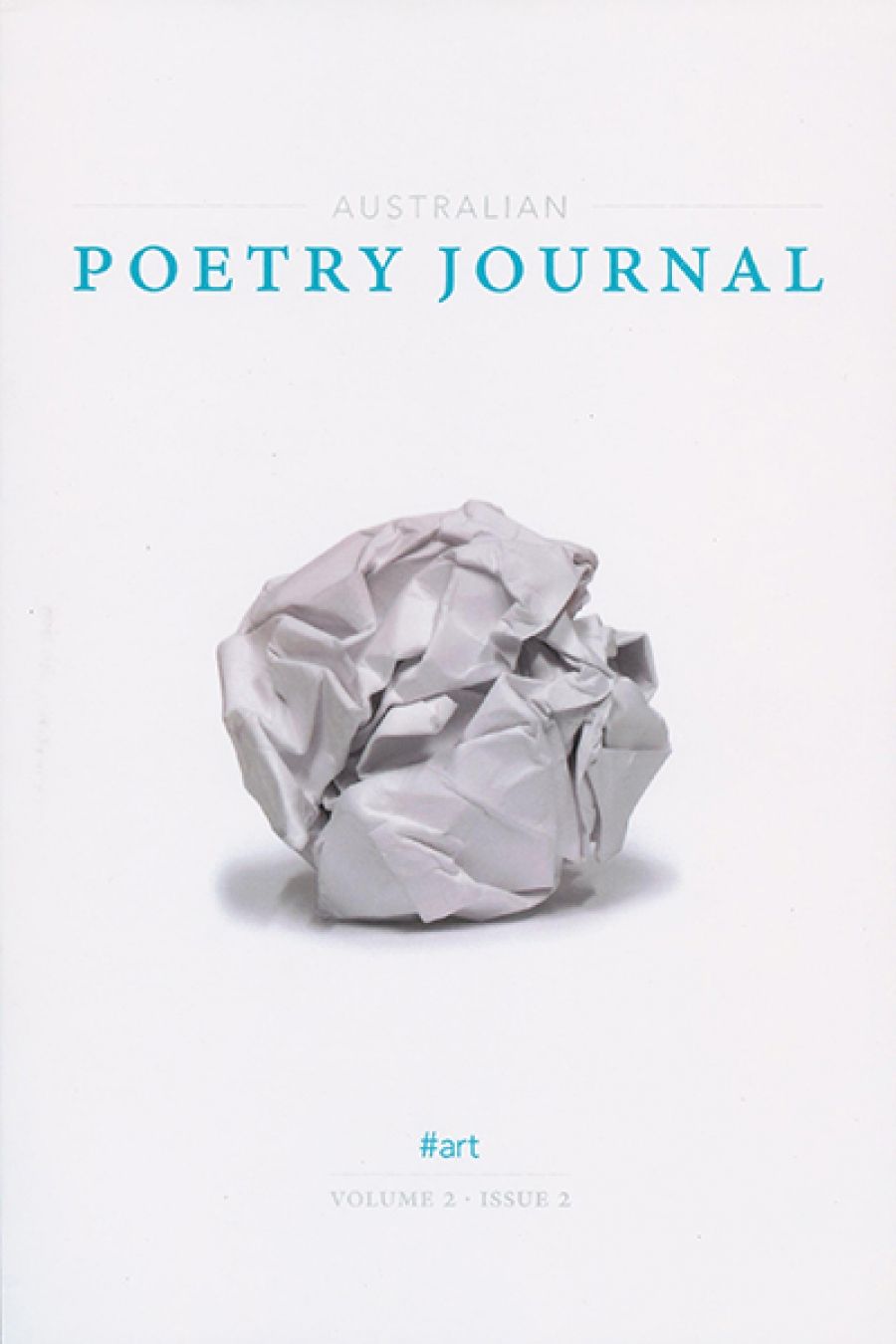
- Free Article: No
- Contents Category: Poetry
- Review Article: Yes
- Online Only: No
- Custom Highlight Text:
Australian Poetry Journal, the flagship publication of Australian Poetry, contains a veritable who’s who of Australian poets. However, this doesn’t mean that the journal is part of the poetry gangland to which some other contemporary Australian journals belong. This is a testament to editor, Bronwyn Lea, who must disappoint many poets – possibly even poet friends or acquaintances – in order to maintain the journal’s impressively high standard. While there are a bevy of famous names on the contents page, Australian Poetry Journal only publishes the best work from these poets and scholars. But it is not just a journal for established poets and poems; emerging poets Davina Allison and Carmen Leigh Keates effloresce in this vaunted company.|
- Book 1 Title: Australian Poetry Journal, Volume 2, Issue 2
- Book 1 Biblio: Australian Poetry Ltd, $25 pb, 140 pp, 9780646591148
Australian Poetry Journal emerged in 2011 after the amalgamation of the Australian Poetry Centre and the Poets Union. In a clever move, their respective journals, Blue Dog and Five Bells, were retired to allow for the more discerning Australian Poetry Journal. This ‘Art’ edition, replete with embossed, crumpled paper on the cover, introduces the subjectivity of art and its appraisal.
Lea’s foreword prioritises the aural nature of poetry by stressing the musicality of the volume and the way it ‘thrums with music’. Indeed, the poems use musical intertexts and epigraphs from Al Jolson to Schubert and prioritise sounds, cadences, and rhythms. The most memorable of these are Kevin Gillam’s ‘Figue’ fugue, where ‘ekphrastic’ is defined as ‘hungering for another’s art’, and Philip Salom’s three waltzes, in which he reimagines Glenn Gould’s alter egos and eccentricities. Salom represents Gould’s addiction to music and drugs – ‘passacaglias of tablet-cats’, polyphonically.
Visually, painters Nolan, Matisse, and Hopper/Rothko inspire Caitlin Maling, Mark Tredinnick, and Brenda Saunders, respectively. Saunders’ s three poems in this volume are intimate and textured, but it is Mike Ladd’s ‘Gallery’ – beginning: ‘I would like to walk into / a painting by Camille Pissarro’ – that delights the reader with the possibility of jumping into paintings by Pissarro, Lautrec, and Soutine in a Mary Poppins-meets-Woody Allen kind of way.
Art in this volume is used in its broadest and most interdisciplinary of interpretations, and the production of art, the reception and effect of poetry, are prioritised. In short, Lea reiterates Dana Gioia’s question, ‘Can Poetry Matter?’, addressing concerns for ‘the state of our art form’. In answer to this, the best poems in this volume are the ones that self-reflexively explore composition. In this way, Alex Skovron’s ‘A Comma Tail’ plays with language and music as ‘Beneath the gables the old colons chortled /… immortalled by their two two beat.’ Similarly, Peter Rose’s ‘Impromptu’ illustrates the transience of an ex tempore moment; the protagonist leaves ‘the poem that Donald Justice / had absently enjoined [him] to pen’, to listen to Schubert’s music floating out of the window, four floors above. Under the threatening gaze of a nesting magpie, the reader imagines the bird, the careful arpeggios, and the protagonist’s unfinished poem mingling above.
Luke Davies’ ‘Peanuts’ is a witty chronicle of Lucy trying to finish a poem while Charlie Brown finds (‘Good grief’) that ‘he was very beautiful / in orbit with her round the lemonade stand’. On a darker note, Stuart Cooke’s ‘Accumulation of Fractures’ features a kind of seppuku: ‘… poetry keeps spilling from a wound in my gut’. In this evisceration, poetry becomes a meaty bullet and results in a ‘young boy hiss[ing] life, life’.
Australian poems are juxtaposed with some outstanding international poetry. Canadian poet Christian Bök’s brilliance leaps off the page in a suite of eight prose poems exploring a dark and evanescent poetry Armageddon. At the funeral pyre for the death of verse, Bök suggests making an offering of ‘the sound of vaginal muscles, tensing in ballerinas’, ‘the kanji glyph for kampei’, and ‘The Registries from Craigslist’. There are also superb poems in translation by Nicola Madzirov (translated by Peggy and Graham W. Reid) and Iman Mersal (translated by Khaled Mattawa).
Finally, Barbara Fisher’s, Susanne Gannon’s, Peter Lach-Newinsky’s, and Rosanna Licari’s poems demonstrate the powerful way in which Australian poets can write about places other than their homeland. But it is Sarah Holland-Batt’s ‘Last Goodbyes in Havana’, beginning ‘Midday cracks like a cold blue cup’, that steals the show and cements her position as a rising star in Australian poetry.
Australian Poetry Journal is also committed to publishing the finest poetry scholarship. In this volume, Robert Adamson provides a profile on Francis Webb and, in a clever merging of critical and creative, reimagines Webb in a poem. Major delights in this journal are the book reviews. In some journals, book reviews can be poorly written and frequently sycophantic; they sometimes read like afterthoughts. However, Stuart Cooke on Kate Lilley’s and Peter Rose’s books, Martin Duwell on Collected Verse of John Shaw Neilson, and Kate Lilley on Julie Chevalier’s and David McCooey’s books are incisive and use rigorous poetry analysis to review a series of impressive Australian poets. Continuing in this trend, Kerry Kilner and Angela Gardner’s ‘The Poetry Book as Art Book’ is an exemplary essay outlining the relationship between art and poetry, and Fiona Scotney’s lively interview with Laurie Duggan on his Coalcliff days is well researched and a fitting way to end the volume.
The future of Australian poetry, judging by the poems and articles in this volume, is both violent and romantic. It is a scintillating chiaroscuro of possibilities.


Comments powered by CComment